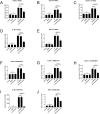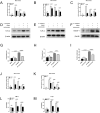Isorhamnetin Ameliorates Aspergillus fumigatus Keratitis by Reducing Fungal Load, Inhibiting Pattern-Recognition Receptors and Inflammatory Cytokines
- PMID: 33783487
- PMCID: PMC8010362
- DOI: 10.1167/iovs.62.3.38
Isorhamnetin Ameliorates Aspergillus fumigatus Keratitis by Reducing Fungal Load, Inhibiting Pattern-Recognition Receptors and Inflammatory Cytokines
Abstract
Purpose: Isorhamnetin is a natural flavonoid with both antimicrobial and anti-inflammatory properties, but its effect on fungal keratitis (FK) remains unknown. The current study aims to investigate the antifungal and anti-inflammatory effects of isorhamnetin against mouse Aspergillus fumigatus keratitis.
Methods: In vitro, the lowest effective concentration of isorhamnetin was assessed by minimum inhibitory concentration and cytotoxicity tests in human corneal epithelial cells (HCECs) and RAW264.7 cells. The antifungal property was investigated by scanning electron microscopy and propidium iodide uptake test. The anti-inflammatory effect of isorhamnetin in HCECs and RAW264.7 cells was observed by quantitative real-time polymerase chain reaction (qRT-PCR). In the eyes of mice with A. fumigatus keratitis, FK severity was evaluated using clinical score, plate counting, histological staining and periodic acid Schiff staining. In vivo, the anti-inflammatory effect of isorhamnetin was examined by immunofluorescence staining, myeloperoxidase assay, Western blot, enzyme-linked immunosorbent assay, and qRT-PCR.
Results: In HCECs and RAW264.7 cells, isorhamnetin significantly inhibited A. fumigatus conidia growth and hyphae viability at 80 µg/mL without affecting cell viability. In vitro, isorhamnetin altered A. fumigatus hyphal morphology and membrane integrity. In A. fumigatus keratitis mouse model, isorhamnetin treatment alleviated the severity of FK by reducing corneal fungal load and inhibiting neutrophil recruitment. In addition, the mRNA and protein expression levels of TLR-2, TLR-4, Dectin-1, IL-1β, and tumor necrosis factor-α were significantly decreased in isorhamnetin-treated groups in vivo and in vitro.
Conclusions: Isorhamnetin improves the prognosis of A. fumigatus keratitis in mice by inhibiting the growth of A. fumigatus, reducing the recruitment of neutrophils and downregulating inflammatory factors.
Conflict of interest statement
Disclosure:
Figures






Similar articles
-
Baicalein Protects Against Aspergillus fumigatus Keratitis by Reducing Fungal Load and Inhibiting TSLP-Induced Inflammatory Response.Invest Ophthalmol Vis Sci. 2021 May 3;62(6):26. doi: 10.1167/iovs.62.6.26. Invest Ophthalmol Vis Sci. 2021. PMID: 34038512 Free PMC article.
-
Quercetin amelioratesAspergillus fumigatuskeratitis by inhibiting fungal growth, toll-like receptors and inflammatory cytokines.Int Immunopharmacol. 2021 Apr;93:107435. doi: 10.1016/j.intimp.2021.107435. Epub 2021 Feb 4. Int Immunopharmacol. 2021. PMID: 33550031
-
Artesunate Treats Aspergillus fumigatus Keratitis by Inhibiting Fungal Activity and Activating Autophagy Pathway to Reduce Corneal Inflammation.Invest Ophthalmol Vis Sci. 2025 Aug 1;66(11):19. doi: 10.1167/iovs.66.11.19. Invest Ophthalmol Vis Sci. 2025. PMID: 40772662 Free PMC article.
-
The role of PPAR in fungal keratitis.Front Immunol. 2024 Dec 23;15:1454463. doi: 10.3389/fimmu.2024.1454463. eCollection 2024. Front Immunol. 2024. PMID: 39763659 Free PMC article. Review.
-
Recent advances in nanotechnology for the treatment of fungal keratitis.Eur J Ophthalmol. 2024 Jan;34(1):18-29. doi: 10.1177/11206721231174653. Epub 2023 May 17. Eur J Ophthalmol. 2024. PMID: 37198915 Review.
Cited by
-
0.01% Hypochlorous Acid Treats Aspergillus fumigatus Keratitis in Rats by Reducing Fungal Load and Inhibiting the Inflammatory Response.Transl Vis Sci Technol. 2023 Aug 1;12(8):3. doi: 10.1167/tvst.12.8.3. Transl Vis Sci Technol. 2023. PMID: 37531113 Free PMC article.
-
Benzyl isothiocyanate improves the prognosis of Aspergillus fumigatus keratitis by reducing fungal load and inhibiting Mincle signal pathway.Front Microbiol. 2023 Feb 16;14:1119568. doi: 10.3389/fmicb.2023.1119568. eCollection 2023. Front Microbiol. 2023. PMID: 36876115 Free PMC article.
-
Clinical Evidence and Potential Mechanisms in Treating Radiation Enteritis with Modified Baitouweng Decoction.Evid Based Complement Alternat Med. 2023 Jan 30;2023:9731315. doi: 10.1155/2023/9731315. eCollection 2023. Evid Based Complement Alternat Med. 2023. PMID: 36756038 Free PMC article. Review.
-
Preparation of a Nanobody Specific to Dectin 1 and Its Anti-inflammatory Effects on Fungal Keratitis.Int J Nanomedicine. 2022 Feb 2;17:537-551. doi: 10.2147/IJN.S338974. eCollection 2022. Int J Nanomedicine. 2022. PMID: 35140463 Free PMC article.
-
A Novel Monoclonal Antibody 1D2 That Broadly Inhibits Clinically Important Aspergillus Species.J Fungi (Basel). 2022 Sep 14;8(9):960. doi: 10.3390/jof8090960. J Fungi (Basel). 2022. PMID: 36135685 Free PMC article.
References
-
- Huang JF, Zhong J, Chen GP, et al. .. A Hydrogel-Based Hybrid Theranostic Contact Lens for Fungal Keratitis. ACS Nano. 2016; 10: 6464–6473. - PubMed
-
- Kredics L, Narendran V, Shobana CS, et al. .. Filamentous fungal infections of the cornea: a global overview of epidemiology and drug sensitivity. Mycoses . 2015; 58: 243–260. - PubMed
-
- Tabatabaei SA, Soleimani M, Tabatabaei SM, et al. .. The use of in vivo confocal microscopy to track treatment success in fungal keratitis and to differentiate between Fusarium and Aspergillus keratitis. Int Ophthalmol. 2020; 40: 483–449. - PubMed
-
- Aveyard J, Deller RC, Lace R, et al. .. Antimicrobial Nitric Oxide Releasing Contact Lens Gels for the Treatment of Microbial Keratitis. ACS Appl Mater Interfaces. 2019; 11: 37491–37501. - PubMed
Publication types
MeSH terms
Substances
LinkOut - more resources
Full Text Sources
Other Literature Sources
Medical
Research Materials

